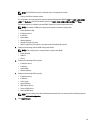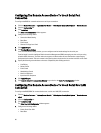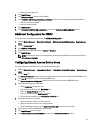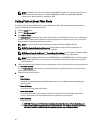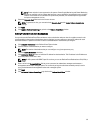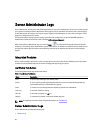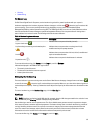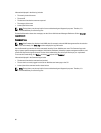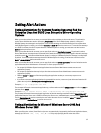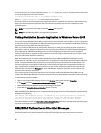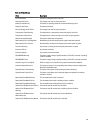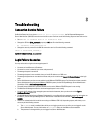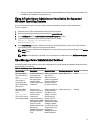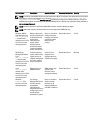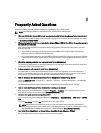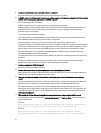7
Setting Alert Actions
Setting Alert Actions For Systems Running Supported Red Hat
Enterprise Linux And SUSE Linux Enterprise Server Operating
Systems
When you set alert actions for an event, you can specify the action to display an alert on the server. To perform this
action, Server Administrator sends a message to /dev/console. If the Server Administrator system is running an X
Window System, the messsage is not displayed. To see the alert message on a Red Hat Enterprise Linux system when
the X Window System is running, you must start xconsole or xterm -C before the event occurs. To see the alert message
on a SUSE Linux Enterprise Server system when the X Window System is running, you must start a terminal such as
xterm -C before the event occurs.
When you set Alert Actions for an event, you can specify the action to Broadcast a message. To perform this action,
Server Administrator executes the wall command, which sends the message to everybody logged in with their message
permission set to Yes. If the Server Administrator system is running an X Window System, the message is not displayed
by default. To see the broadcast message when the X Window System is running, you must start a terminal such as
xterm or gnome-terminal before the event occurs.
When you set Alert Actions for an event, you can specify the action to Execute application. There are limitations on the
applications that Server Administrator can execute. To ensure proper execution:
• Do not specify X Window System based applications because Server Administrator cannot execute such
applications properly.
• Do not specify applications that require input from the user because Server Administrator cannot execute such
applications properly.
• Redirect stdout and stderr to a file when specifying the application so that you can see any output or error
messages.
• If you want to execute multiple applications (or commands) for an alert, create a script to do that and insert the full
path to the script in the Absolute path to the application box.
Example 1: ps -ef >/tmp/psout.txt 2>&1
The command in Example 1 executes the application ps, redirects stdout to the file /tmp/psout.txt, and redirects stderr to
the same file as stdout.
Example 2: mail -s "Server Alert" admin </tmp/alertmsg.txt>/tmp/mailout.txt 2>&1
The command in Example 2 executes the mail application to send the message contained in the file /tmp/alertmsg.txtto
the Red Hat Enterprise Linux user or SUSE Linux Enterprise Server user, and Administrator, with the subject Server Alert.
The file /tmp/alertmsg.txt must be created by the user before the event occurs. In addition, stdout and stderr are
redirected to the file
/tmp/mailout.txt in case an error occurs.
Setting Alert Actions In Microsoft Windows Server 2003 And
Windows Server 2008
When specifying alert actions, Visual Basic scripts are not automatically interpreted by the Execute Application feature,
although you can run a .cmd, .com, .bat, or .exe file by only specifying the file as the alert action.
67



